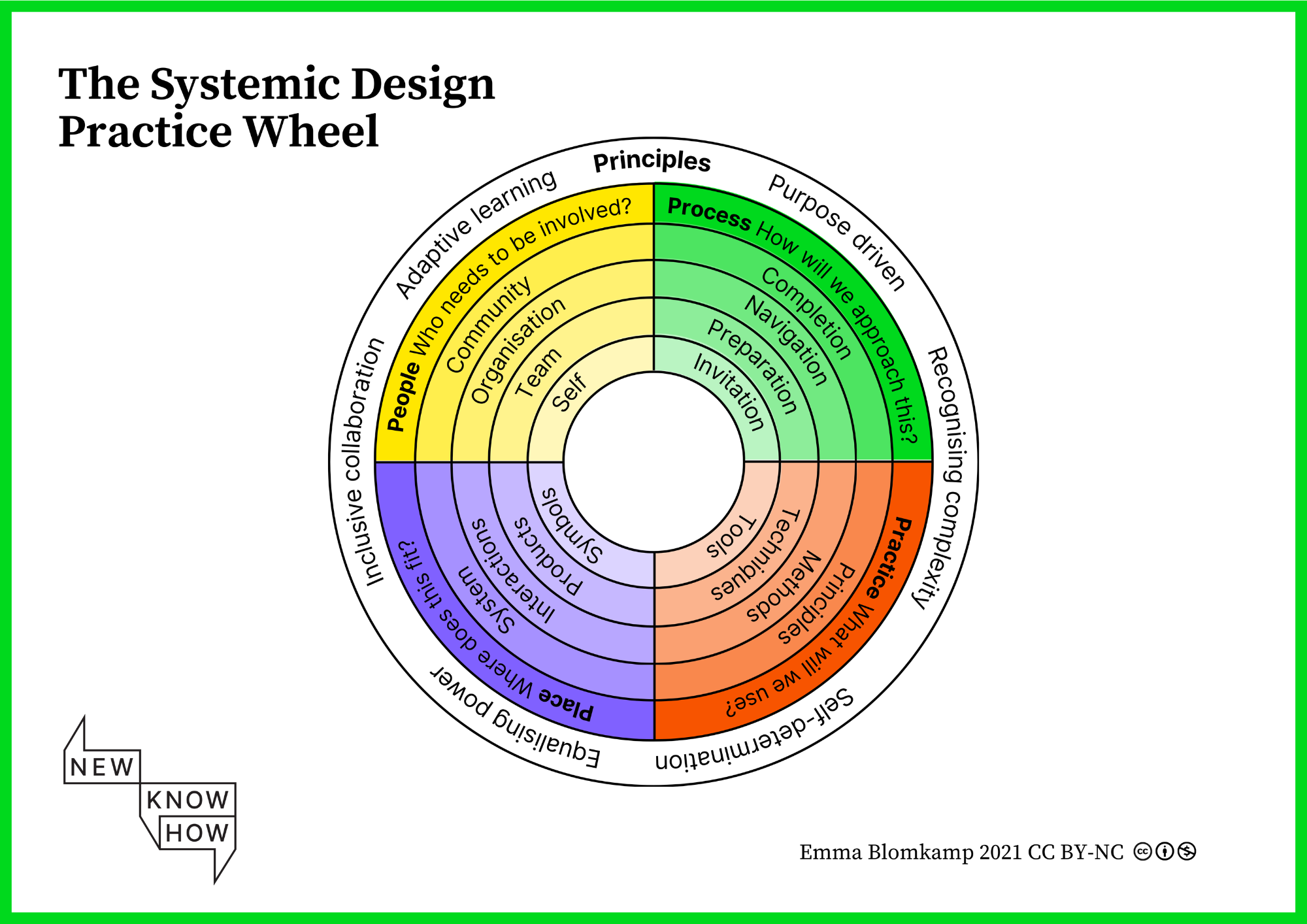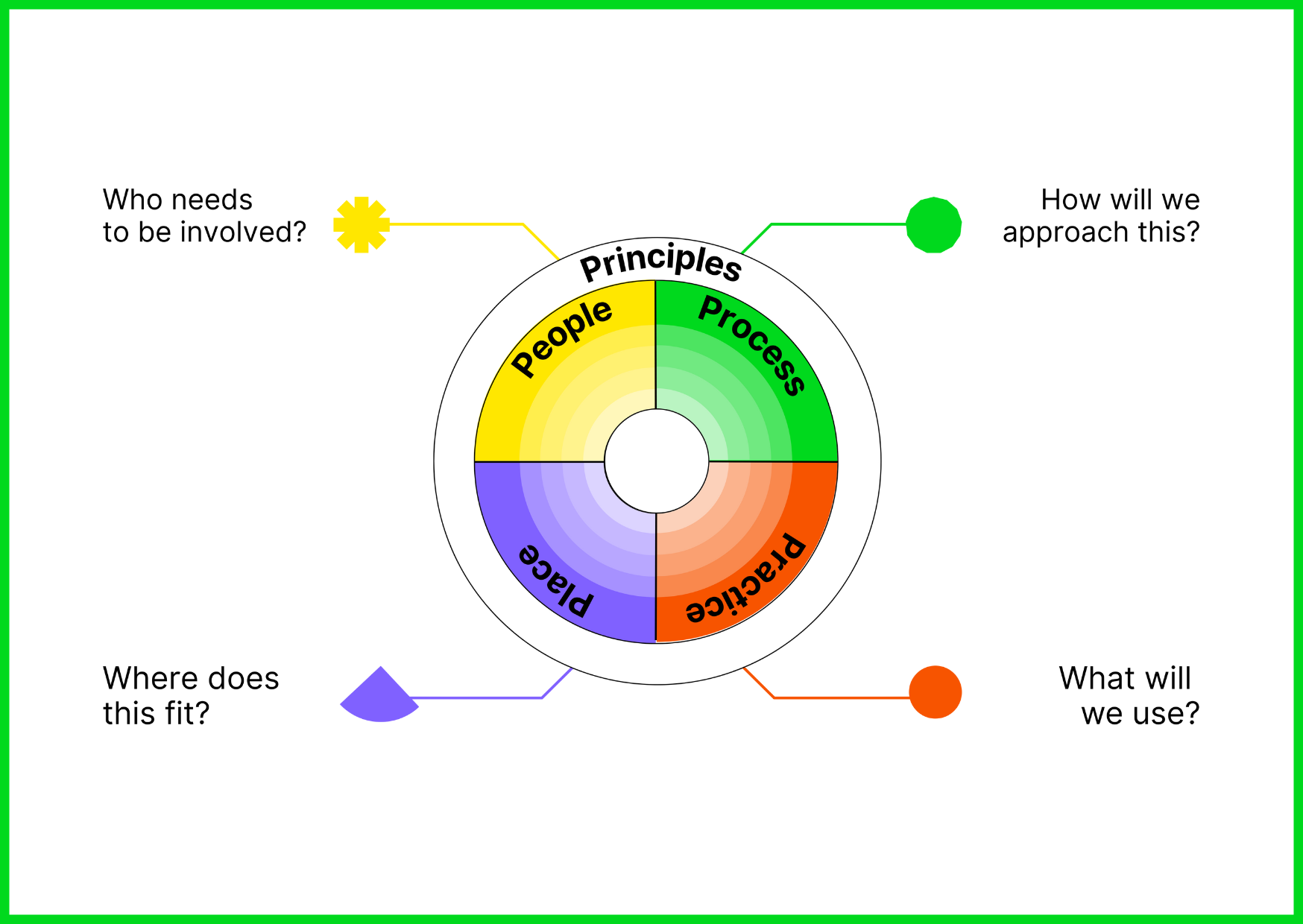Systemic Design Practice Wheel
The Systemic Design Practice Wheel is a practical framework that guides practitioners taking creative and participatory approaches to complex problems. Underpinning our work at New Know How, it distils experience and knowledge from research, evaluation, education and practice in design for public and social innovation.
The framework centres on five core domains – principles, place, people, process and practice – covering key considerations for those working with partners and communities on shared challenges. It integrates systems thinking, human-centred design and participatory design to articulate what needs to be considered when tackling complex problems and designing for social change.
This follows Peter Jones’ definition of systemic design as “a design-led practice that integrates dialogue in co-creation for sensemaking and decision making” (see Blomkamp 2021).
The Wheel has been designed to orient practitioners, managers and commissioners towards ethical and effective ways of collaborating for social impact. It functions as a compass, not a map – offering a set of considerations and questions rather than a step-by-step ‘how to’ guide or one-size-fits-all toolkit.
Understanding the five domains
One way to understand systemic design is as a dance (see also: Meadows). Each domain of the Systemic Design Practice Wheel represents essential considerations for this practice.
Purpose (and other principles)
Why are you dancing? The principles are your North Stars (or Southern Cross), guiding all action. Purpose sets the tone and delineates right and wrong ways to proceed. This framework highlights six core principles, based on a synthesis of successful case studies and academic literature: purpose-driven, inclusive collaboration, self-determination, equalising power, recognising complexity and adaptive learning.
Place (context and conditions)
When and where are you dancing? Place reminds us to always consider the local and nested contexts within which we are working, as well as the timing and level or scale of the work, and its connections with other activities and systems. All sorts of contextual factors – from the political and historical context to the physical and organisational environment – will affect the work.
People (relationships and participation)
Who is dancing? People highlights the individuals and groups involved, the different roles that need to be filled, and the importance of relationships and caring for those participating in and affected by the work. Not everyone can or will dance the same way. Considerations include yourself, your team, the organisations involved, and members of the broader community (people with relevant lived, living, professional, specialist and cultural expertise).
Process (planning and stewardship)
How will you dance? Process encourages us to think about structures and movement that enable and constrain the work in different spaces and phases over time. Depending on the kind of work it is, you may have to follow certain conventions or perform certain steps – from invitation and preparation, through navigation, to completion.
Practice (skills and techniques)
What are the moves? Practice encompasses the tasks, tools and techniques used in carrying out the work. This domain draws attention to the knowledge, skills and structures that support reflection and action. Like dance, systemic design is a craft that must be practised. And the more you practise it, learning from your mistakes, the better you will become.
How to use it
The Systemic Design Practice Wheel can support practitioners, participants and supporters at key moments in systems change work, including for:
Project planning
Practice reflection
Reviewing and evaluating work
Training and professional development
Coaching and supervision
Aside from the six principles, each domain has an overarching question and four key elements to consider, helping teams navigate complex challenges while remaining grounded in purpose and values.
We freely provide a range of downloadable resources with additional guidance below, so that you can apply (and adapt) the Systemic Design Practice Wheel to your work.
Uses, resources and attribution
The Systemic Design Practice Wheel is shared under a CC BY-NC licence, meaning it’s free for anyone to use, adapt and share for non-commercial purposes, with attribution to its creator, Emma Blomkamp.
Academic reference
The development of the Systemic Design Practice Wheel is described in detail in an open access, peer-reviewed article: Systemic Design Practice for Participatory Policymaking published in 2021 in Policy Design and Practice. The framework emerged as an analytical tool to explain promising practice in a case study of design-led policymaking.
Training and learning
If you’re interested in learning more about applying the framework, consider taking our short course Leading Co-Design in Complex Systems, which is structured around the five domains of the framework.
Downloadable resources
The framework is available in multiple formats to support different uses:
Planning and reflection canvas (PDF): for digital use (e.g. on Miro) or printing (A4 or A3 size)
Reference sheet (PDF): includes guiding questions for each domain to support reflection and planning.
Questions or feedback?
For feedback, suggestions for improvement, or to be notified of future iterations, feel free to contact us.


